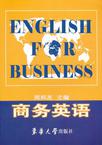商务英语
出版时间:2011-8 出版社:东华大学出版社 作者:周邦友 编 页数:242
内容概要
This book altogether eight parts, which, we think, are all related to communication in business contexts. The first part offers some remarks on English for Business, dealing with the features of business English and the significance of business communication. The next five parts respectively relate to business letters, business plans, contracts, advertising, and trademarks with examples and illustrations. Part Seven presents commonly- used documents in international business on sample basis. In the last part, the authors point out that it is important for people doing international business to raise their cross--cultural awareness.
书籍目录
Part 1 General Remarks on English for Busim
1.1 Definition of English for Business
1.2 A Briefing on English for Business
1.3 Specialist Vocabulary
1.4 Syntax and Figure of Speech
1.5 Principles of Business Writings
l.5.1 Clearness
1.5.2 Conciseness
1.5.3 Correctness
1.5.4 Courtesy
1.5.5 Concreteness
1.5.6 Consideration
1.5.7 Completeness
1.6 Choice of English Varieties
1.7 Tips for Business Writings
Part 2 Business Letters
2.1 Planning a Business Letter
2.2 Business Letter Format
2.3 Lay—out of a Business Letter
2.3.1 Letterhead
2.3.2 Lay—out
2.4 Language of Business Letters
2.5 Different Types of Business Letters
2.5.1 Establishing Business Relations
2.5.2 Inquiries and Replies
2.5.3 Quotations,Offers and Counter Offers
2.5.4 0rders
2.5.5 Payment
2.5.6 Packing
2.5.7 Insurance
2.5.8 Shipment
2.5.9 Acknowledgements
2.5.10 Complaint and Reply
Part 3 Business PIan
3.1 The Language Features
3.2 The Elements of a Business Plan
3.3 HOW to Write
3.4 Samples
Part 4 Contract
4.1 The Language Features
4.2 The Elements of a Contract
4.3 HOW to Write
4.4 Samples
Part 5 Advertising
5.1 Lexical Features
5.1.1 Simple and Informal
5.1.2 Misspelling and Coinage
5.1.3 Loanwords
5.1.4 Contraction
5.1.5 Use of Verbs
5.1.6 Use of Adjectives
5.1.7 Compound Words
5.1.8 Pronouns
5.2 Figures of Speech
5.2.1 Personification
5.2.2 Puns
5.2.3 Alliteration
5.2.4 Repetition
5.2.5 Analogy
5.2.6 Rhyme
5.2.7 Hyperbole
5.2.8 Parallelism
5.2.9 Paradox
5.2.10 Omission
5.3 Fuzziness
5.4 Weasel Words
5.5 Syntactical Features
5.5.1 Simple Sentences
5.5.2 Narrative Sentences
5.5.3 Imperative Sentences
5.5.4 Interrogative Sentences
5.5.5 Elliptical Sentences
5.5.6 Disiunctive Clauses
5.5.7 Use of the Active Voice
5.5.8 Negative Sentences
5.5.9 Use of the Present Tense
5.6 Discourse Features
5.7 Visual Effects of Body Copies
Part 6 Trademark Creation
6.1 Definitions of Trademark
6.2 Attributes of Trademark
6.3 Categories of Trademark
6.3.1 Fanciful Trademark Strong
6.3.2 Arbitrary Trademark—Strong
6.3.3 Suggestive Trademark—Fairly Strong
6.3.4 Descriptive Trademark—Not Strong
6.3.5 Generic Trademark—Weak and Not Protectable
6.4 Strategies for Trademark Creation
6.4.1 Choose a Connotative Term
6.4.Z Use an Acronym
6.4.3 Invent a Term
6.4.4 Borrow a Foreign Term
6.4.5 Select a Term from Related Areas
6.5 Guidelines for Trademark Creation
6.5.1 Avoid Trademarks That Cannot Be Registered
6.5.2 Use Fabricated Words
6.5.3 Try Animal or Plant Names
6.5.4 Make the First Trademark Word Distinctive
6.6 Methods of Creating a Trademark
6.6.1 Clipping
6.6.2 Blending
6.6.3 Initialism
6.6.4 Acronym
6.6.5 Compounding
6.6.6 Affixing
6.6.7 Homophones
6.6.8 Echoism
6.6.9 Reversal
6.7 Value of Trademark
6.8 Protection of Trademarks
6.8.1 Use Trademarks as Adjectives
6.8.2 Consider Using Distinctive Type
6.8.3 Use Trademark Notice
6.8.4 Don’t Change a Trademark
6.8.5 Don’t Use Trademarks in the Possessive Case
6.8.6 Don’t Use Trademarks in the Plural Form
6.9 Comparison between English and Chinese Trademarks
6.9.1 Similarities Between English and Chinese Trademarks
6.9.2 Differences Between English and Chinese Trademarks
Part 7 International Trade D0cumentation
7.1 Quotation Sheet
7.2 Letter of Credit
7.3 Bill of Exchange
7.4 Proforma Invoice
7.5 Commercial Invoice
7.6 Packing List
7.7 Bill of Lading
7.8 Certificate of Origin
7.9 Weight Memo
7.10 Inspection Certificate
7.1 1 Shipping Advice
7.12 Insurance Policy
7.13 Relevant Certificates
Part 8 Cross.Cultural Awareness
8.1 Cultural Contrast
8.1.1 Individual VS.Group
8.1.2 Low Power—Distance VS.High Power—Distance
8.1.3 High Uncertainty—Avoidance VS.Low
Uncertainty—Avoidance
8.1.4 Masculinity VS.Femininity
8.1.5 Low—Context VS.High—Context
8.2 Cultural Differences
8.2.1 Time
8.2.2 Space
8.2.3 Religion
8.2.4 Feature
8.2.5 Color
8.3 Culture Shock
8.4 Cultural Confluence
8.5 Tips for Cross—Cultural Communication
Bibliography
图书封面
评论、评分、阅读与下载
用户评论 (总计3条)
- 心得很多。。。
- 很全面,很详细,good!
- 当时大学课本,在网上买的,内容一般般。
